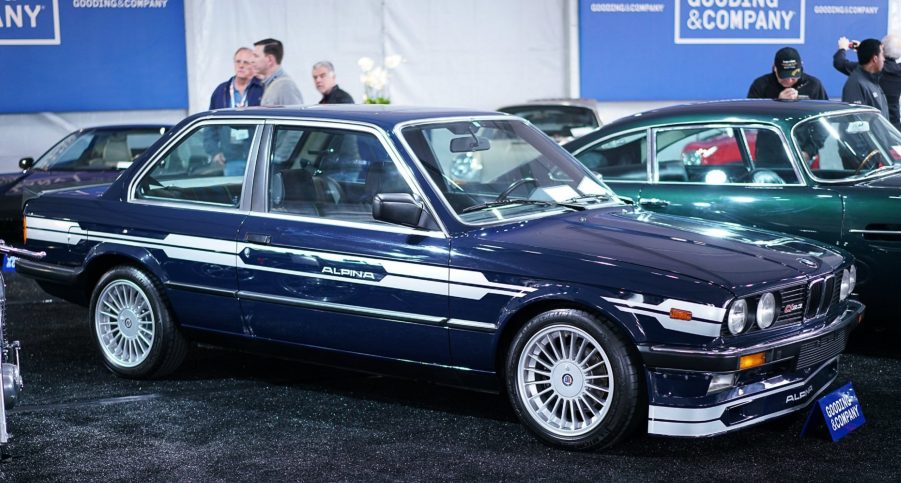
Rarer and More Special Than an E30 M3: BMW Alpina C1 2.3
More than its performance figures, the original E30 M3 is an icon today because of its raw, driver-focused nature. However, while it was a true race car homologation special, it wasn’t the only performance-minded E30 BMW 3 Series. It’s just that some of these sportier E30 models, such as the ‘Italian tax special’ 325is, are rarely seen even within the BMW fandom. But if you really want to talk about obscure E30s, you need to know about the E30 Alpina C1 2.3.
The 1983-1985 Alpina C1 2.3 is like a luxurious M Performance E30 BMW 3 Series

Before M Division ever made a road car, independent tuner/manufacturer Alpina was giving BMWs some extra autobahn and racetrack cred. How much cred? Well, consider this. The first M5 to break the 300-hp barrier was the 1991 E45. By that point, Alpina had been offering a 300-hp 5 Series model for roughly a decade.
However, not all Alpina cars were fire-breathing monsters, in the same way that not all M-badged BMWs are true M cars. Some of them are M Performance models instead. And so it goes with the 1983-1985 E30 Alpina C1 2.3.
The successor to the E12-based Alpina C1 2.3, the E30 model, often called ‘C1 2.3/1,’ was sort of like an early ‘80s M440i. Admittedly, the E30 BMW M3 technically didn’t exist at the time. But there was a more extreme E30-based Alpina available, the B6, The Drive explains. In this case, the B6 played the M4 to the C1 2.3’s M440i.
However, while it’s not an E30 M3, the Alpina C1 2.3 is much more than a decal-strewn BMW 3 Series.
It’s oft-forgotten, but the C1 2.3 is a true classic sports sedan

Alpina is no less focused on performance than M Division, but it does speed with its unique flair. The current Alpina XB7, for example, sacrifices some of the X7 M’s sharpness for greater high-speed stability and comfort. Yet it still goes 0-60 mph in 4.0 seconds. And it’s the same story with the E30 Alpina C1 2.3.
Compared to the E30 BMW M3, the Alpina C1 2.3 is less powerful. However, its eponymous upgraded ‘M20’ 2.3-liter inline-six engine makes 170 hp, Gooding & Co reports. Even after its mid-1983 upgrade, the 323i that the C1 is based on only made 148 hp. And while the C1’s 7.8-second 0-62 mph time doesn’t seem fast today, it was in 1983.
But as with its modern cars, Alpina didn’t just give the E30 323i more power. The C1 2.3/1 has Bilstein shocks, enlarged four-wheel ventilated disc brakes, and lighter alloy wheels, too. Also, a functional rear spoiler, front splitter, striped Recaro sport seats, a leather-wrapped sport steering wheel, and a wooden shift knob. And, apart from the ‘Alpina’ graphics, it looks just like a regular E30 BMW 3 Series, the Wall Street Journal says.
Admittedly, the Alpina C1 2.3/1 isn’t as fast or as sharp as the later E30 M3. However, because it has a smooth inline-six rather than a rev-happy four-cylinder, it’s more refined on the road. And it’s not a stripped-down race car, either, but a capable classic tool that’s at home on back roads and highways. Also, while the E30 M3 isn’t exactly rare, it’s far more common than the C1.
The E30 Alpina C1 2.3 is one of the rarest E30 BMW 3 Series models
Alpina never makes large batches of cars each year, but it produced particularly few E30 2.3/1s. The German shop only made 35 examples from 1983-1985, the WSJ reports. In comparison, BMW made almost 18,000 E30 M3s. There are over 17 times as many E30 M3 Sport Evolutions as there are C1 2.3/1s.
However, while these hopped-up E30s are hard to find, they’re also significantly more affordable than an E30 M3. Those cars often sell in the $100,000 range these days. In comparison, an E30 Alpina C1 2.3 is usually about half that price. The last example Gooding & Co. sold went for $51,700 in 2017.
Also, how many BMWs can make an E30 M3 seem commonplace?
Follow more updates from MotorBiscuit on our Facebook page.


